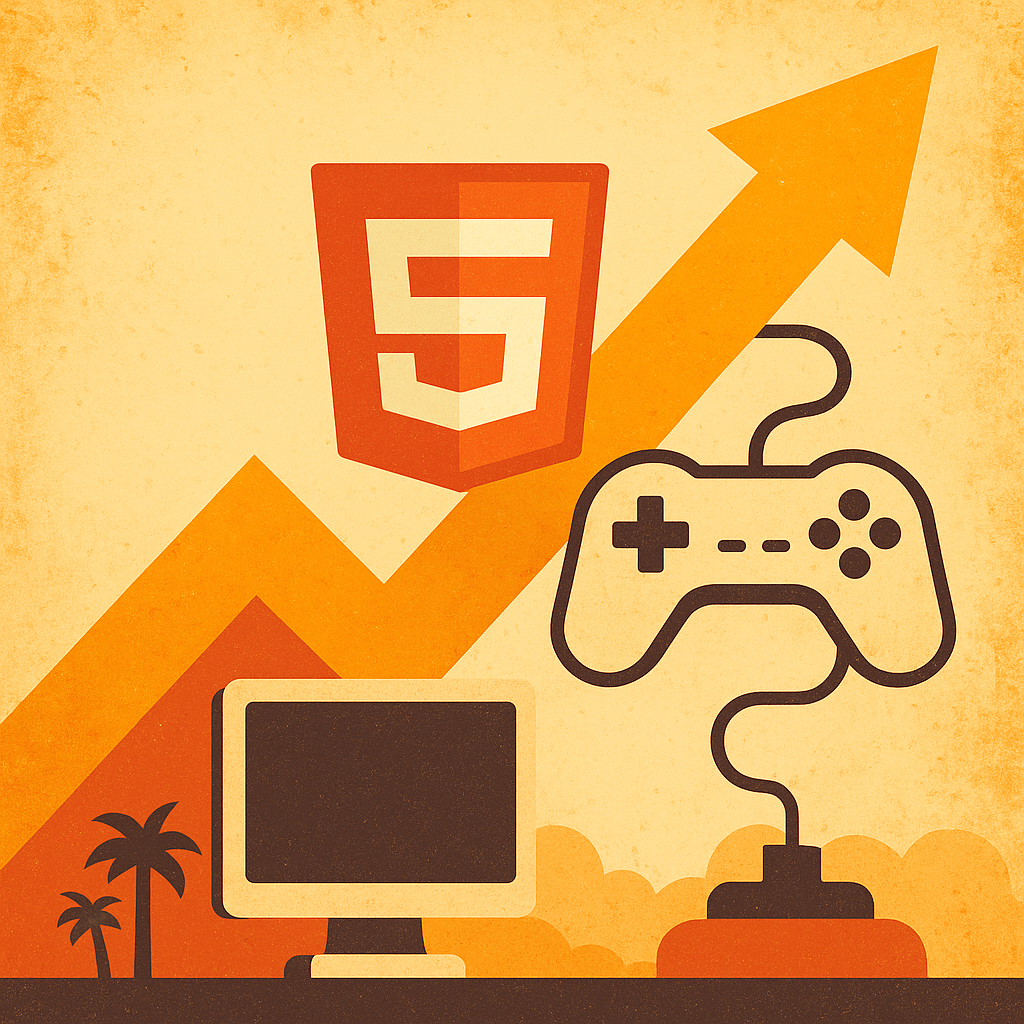A Comeback Story: How HTML5 Games Are Making Their Mark Again
In the fast-evolving world of gaming, where cutting-edge graphics and massive download sizes often dominate headlines, an unlikely hero is making a remarkable comeback: HTML5 games. Once dismissed as simple browser-based diversions, these lightweight, instantly-accessible games are experiencing explosive growth that’s catching the attention of developers, publishers, and investors worldwide.
The HTML5 games market is exploding. For instance, Google and Kantar estimate it will triple from $1.03 billion in 2021 to $3.09 billion by 2028. That’s massive growth driven by instant accessibility. Meanwhile, Verified Market Research sees even bigger potential. They project growth from $1.03 billion in 2023 to $3.09 billion by 2031. Consequently, this represents a compound annual growth rate of 16.7%. On the other hand, Business Research Insights takes the broadest view. They value the global HTML5 games market at $5.32 billion in 2024. Furthermore, their forecast reaches $9.22 billion by 2033 with a 6.3% CAGR.
The variation in estimates reflects different methodologies. Some focus narrowly on mobile-only segments. In contrast, others capture the broader ecosystem including advertising and development services. Nevertheless, regardless of which projection proves accurate, growth is undeniable.
Contents
What’s Driving This Gaming Revolution?
Instant Play Changes Everything
Modern consumers hate waiting. Fortunately, HTML5 games solve this problem perfectly. They run directly in web browsers without downloads or installations. As a result, no waiting means more players actually try your game. Additionally, these games work across all devices. Smartphones, tablets, desktops, and smart TVs all support them. Therefore, this universal compatibility opens massive market opportunities. Players can start gaming within seconds of clicking a link.
Traditional mobile games require app store visits. Users must download large files and wait for installation. In contrast, HTML5 games eliminate these friction points entirely. Consequently, the result is higher conversion rates and broader audience reach.
Mobile Growth Creates New Opportunities
The global smartphone boom continues accelerating. At the same time, better internet access reaches previously untapped markets. HTML5 games are perfectly positioned for this expansion.
Emerging markets face unique challenges. Data costs remain high and device storage is limited. However, HTML5 games address both issues with lightweight designs. They load quickly over slower connections and don’t consume storage space. This accessibility advantage is driving adoption worldwide. Markets that couldn’t support traditional gaming are embracing HTML5 alternatives. As a result, the consequence is explosive growth in player bases.
Development Activity Is Skyrocketing
The first half of 2025 saw incredible activity. Over 15,000 HTML5 games were released during this period. That’s a 2.7x increase compared to 2024’s first half. Currently, Unity dominates the development landscape with 55% market share. However, other engines are gaining ground rapidly. For example, Construct claims 16.4% of new releases. Similarly, Cocos and Phaser capture 8.1% and 7.1% respectively.
This diversity in development tools is healthy. It prevents monopolization and encourages innovation. Particularly exciting are open-source options like Phaser. They lower barriers for independent developers.
Technology Finally Delivers on Promise
Early HTML5 games were technically limited. Browser performance constraints held back ambitious projects. However, those days are over thanks to advancing web standards. For instance, WebAssembly enables near-native performance for complex games. Meanwhile, WebGL2 unlocks sophisticated graphics capabilities. Additionally, the emerging WebGPU standard promises even better visual fidelity.
These advances support modern game features. AI integration is becoming standard. Furthermore, cloud connectivity enables persistent worlds. Real-time data processing powers dynamic content. Finally, multiplayer functionality works seamlessly across platforms.
The Player Base Is Evolving
HTML5 games attract serious gamers, not just casual players. Recent data shows 42% of all gamers played HTML5 games in mid-2023. This nearly matches PC gaming (48%) and console gaming (47%) participation rates. The demographic data is surprising. Nearly half of HTML5 players identify as core gamers. These dedicated players spend over seven hours weekly across gaming platforms. They’re not seeking quick diversions—instead, they want engaging experiences.
This shift challenges old assumptions about browser gaming. HTML5 is becoming a legitimate gaming category. It’s no longer just a casual alternative to “real” games. Moreover, age demographics span all generations. Young players appreciate instant access. At the same time, older gamers value the simplicity of browser-based play. Both groups are driving sustained engagement numbers.
Monetization Gets Sophisticated
Early HTML5 games relied heavily on banner advertising. However, today’s monetization strategies are far more sophisticated. Developers are implementing proven mobile game techniques. In-app purchases are becoming standard. Players can buy power-ups, cosmetics, and premium content. Interestingly, the instant-access nature of HTML5 games actually helps conversion rates. Players can start engaging immediately without download delays.
Rewarded video ads represent a major opportunity. These ads offer in-game benefits for viewing short videos. Player engagement with rewarded content is typically higher than forced advertising. Therefore, this creates win-win scenarios for developers and advertisers. Companies like Applixir specialize in HTML5 game monetization. They provide tools and platforms optimized for browser-based games. Their solutions help developers maximize revenue while maintaining player satisfaction.
Subscription models are also emerging. Premium HTML5 gaming platforms offer ad-free experiences. Some provide exclusive content libraries. Others focus on enhanced social features and cloud save functionality.
Furthermore, platform-based revenue sharing is growing rapidly. Dedicated HTML5 gaming portals are developing sophisticated monetization systems. These platforms handle advertising, payments, and player acquisition. As a result, developers can focus on creating great games.
Distribution Advantages Are Clear
HTML5 games bypass traditional app store gatekeepers. There are no approval processes or revenue splits required. Consequently, developers maintain direct relationships with their audiences. Social media integration is seamless. Games can be shared instantly through links. This viral potential is harder to achieve with downloaded applications. Therefore, word-of-mouth marketing becomes incredibly powerful.
Search engine optimization works naturally with HTML5 games. Web crawlers can index game content and metadata. This organic discoverability is valuable for smaller developers. It reduces dependence on expensive user acquisition campaigns. Cross-platform compatibility eliminates the need for multiple versions. One HTML5 game works everywhere. This dramatically reduces development and maintenance costs. As a result, resources can be focused on improving gameplay rather than porting.
Challenges Still Exist
Browser compatibility issues persist despite improvements. Different engines handle HTML5 features inconsistently. Therefore, developers must test across multiple platforms and versions. This adds complexity to the development process. Performance optimization remains crucial for success. HTML5 games must compete with native applications. Players expect smooth frame rates and responsive controls. Achieving this requires careful programming and resource management.
Discoverability represents an ongoing challenge. Thousands of new HTML5 games launch monthly. Standing out in this crowded market requires marketing savvy. Quality alone isn’t sufficient for commercial success. Security concerns affect both developers and players. Browser-based games face unique vulnerability risks. Therefore, proper implementation of security measures is essential. This includes protecting user data and preventing cheating.
The Future Looks Bright
HTML5 gaming represents fundamental shifts in digital entertainment consumption. Attention spans are fragmenting globally. At the same time, accessibility is becoming more important than ever. Instant gratification drives modern consumer behavior. For developers, this creates enormous opportunities. Global audiences become accessible without traditional barriers. App store restrictions don’t apply. Additionally, platform fees can be avoided entirely. Distribution becomes democratized.
Players benefit from expanding game libraries. New titles appear daily across every genre. Complex strategy games sit alongside simple puzzles. All are instantly playable without downloads or payments. The technology continues advancing rapidly. Future web standards promise even better capabilities. Virtual reality support is already emerging. Meanwhile, augmented reality integration is being explored. The possibilities seem endless.
Investment money is flowing into the space. Venture capital firms recognize the growth potential. This funding accelerates innovation and quality improvements. As a result, professional game studios are taking HTML5 seriously.
AppLixir Game Monetization
The HTML5 gaming comeback story continues writing itself. Early chapters show incredible promise and momentum. Market growth exceeds most predictions. Furthermore, player engagement demonstrates lasting appeal. What started as simple browser games is evolving rapidly. Today’s HTML5 titles rival traditional gaming experiences. Tomorrow’s versions may define the future of interactive entertainment.
The barriers between “browser games” and “real games” are disappearing. HTML5 technology enables previously impossible experiences. Creative developers are pushing boundaries daily. This isn’t just a temporary trend or nostalgic revival. HTML5 games are positioning themselves as the future. They offer universal accessibility in an increasingly connected world. Instant gratification meets sophisticated gameplay.
Keep watching HTML5 games closely in 2025 and beyond. The comeback story is just beginning. These browser-based experiences may well become gaming’s dominant platform. In our impatient, mobile-first world, instant play could rule everything.


